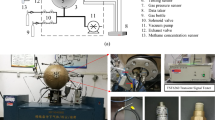Abstract
A series of full-scale explosion suppression experiments were conducted in a compartment. The suppression performance of three extinguishing systems with two suppressants for the deflagration-type explosion was studied. The impact of agent discharge direction, the presence of an obstacle and the use of additives on suppression performance were investigated with extensive data collection and analysis. The negative aspects and toxicity issues associated with the protection systems are also addressed in the paper. The three extinguishing systems evaluated in this project were a high pressure HFC-227ea (FM-200) extinguisher, a hybrid gas generator with FM-200, and a hybrid gas generator with water, with full-system hardware including optical flame sensors and electronic controllers. The experimental results showed that the explosion in a compartment originating from a fuel spray was a serious threat to any occupant in the compartment and could cause major damage to equipment, but, the explosion generated in the experiments was controlled or extinguished by appropriate extinguishing systems.














Similar content being viewed by others
References
J.Z. Su and A.K. Kim, “Review of Halon Replacement Agents for Total-Flooding Fire Suppression in Unoccupied Spaces,” National Research Council Canada, Ottawa, Client Report A-4421.1, December 13, 1996.
J.Z. Su, Z. Liu, A.K. Kim, G.P. Crampton, and M. Kanabus-Kaminska, “Fire Suppression Testing of HFC-125, CF3I and IG-541 for Fire Protection in Engine Compartment of the Leopard C1 Tank,” National Research Council Canada, Ottawa, Client Report B-4101.1, July 27, 1998.
S. McCormick, M. Clauson, and H. Cross, “US Army Ground Vehicle Halon Replacement Programs,” Halon Options Technical Working Conference, Albuquerque, New Mexico, USA, April 1999, pp. 27–33.
P.E. Moore, “Suppressants for the Control of Industrial Explosions,” Journal of Loss Prevention Process, vol. 9, no. 1, 1996, pp. 119–123.
J.Z. Su and A.K. Kim, “Review of Explosion Protection Technology for Crew Compartment,” National Research Council Canada, Ottawa, Client Report B-4123.1, August 31, 2001.
A. Chattaway, R.G. Dunster, D.J. Spring, and M. Way, “Evaluation of Alternative Agents for Suppression Fuel Spray Explosions in Military Vehicle Crew Compartments,” Halon Options Technical Working Conference, Albuquerque, New Mexico, USA, April 1999, pp.27–33, 45–53.
S. McCormick, M. Clauson, and H. Cross, “US Army Ground Vehicle Crew Compartment Halon Replacement Programs,” Halon Options Technical Working Conference, Albuquerque, New Mexico, USA, May 2000, pp. 229–236.
P. Wierenga, “Advanced Environmentally Friendly Fire Protection Technology,” Halon Options Technical Working Conference, Albuquerque, New Mexico, USA, April 2001.
NFPA 2001, “Standard on Clean Agent Fire Extinguishing Systems,” National Fire Protection Association, Quincy, MA, USA, Edition, 1996, pp. 1–80.
Acknowledgments
Authors would like to acknowledge the assistance of Drs. Malgosia Kanabus-Kaminska and Joseph Su in operating the FTIR apparatus and analyzing the gas measurement data. Authors would also like to acknowledge the assistance of Mr. Cameron McCartney in the planning of the experiment, and Mr. Michael Ryan in setting up and instrumenting the test compartment. The assistance of General Dynamics by providing the necessary hardware for the extinguishing systems is greatly appreciated. Special appreciation goes to Mr. Paul Wierenga and Mr. Gary Gregg of General Dynamics for their assistance in setting-up the extinguishing systems and their controllers during the experiments. This study was conducted under the Halon Alternatives Performance Evaluation Program, a joint research project between the Department of National Defence and the National Research Council of Canada.
Author information
Authors and Affiliations
Corresponding author
Rights and permissions
About this article
Cite this article
Kim, A., Liu, Z. & Crampton, G. Study of Explosion Protection in a Small Compartment. Fire Technol 43, 145–172 (2007). https://doi.org/10.1007/s10694-007-0008-6
Received:
Accepted:
Published:
Issue Date:
DOI: https://doi.org/10.1007/s10694-007-0008-6




